![]()
The user strongly advised/encouraged to create a backup copy of the entire BatchSheet folder, including its subfolders, for future reference and protection against accidental file corruption, deletion, etc.
The batch sheet report generation relies on the existence of a “master form” document. The “master form” is the top-level MS-Word document containing the batch sheet structure; it can contain references to flowsheet properties directly, and references/links to other forms related to flowsheet elements such as operations, procedures, streams, etc.
The default “master form” is installed with SPD as Application Dir\BatchSheet\master.doc, where “Application Dir” is the current SPD installation directory.
The default set of operation templates is installed on the system in the path Application Dir\BatchSheet\Operations.
|
|
The user strongly advised/encouraged to create a backup copy of the entire BatchSheet folder, including its subfolders, for future reference and protection against accidental file corruption, deletion, etc. |
To generate a batch sheet report with the click of a button, select Reports\Batch Sheet\Generate from the SPD Reports menu. The default templates will be used and the batch sheet report will be created in the system directory where the SPD case file resides. This is the easiest way to generate a batch sheet report with the default options. Significant customization of the process is available through the Reports\Batch Sheet\Options menu item.
For further information on the Batch Sheet Options please, see Batch Sheet Options.
The “Batch Sheet Options” dialog contains several batch sheet customization options. A snapshot of the dialog is shown below.
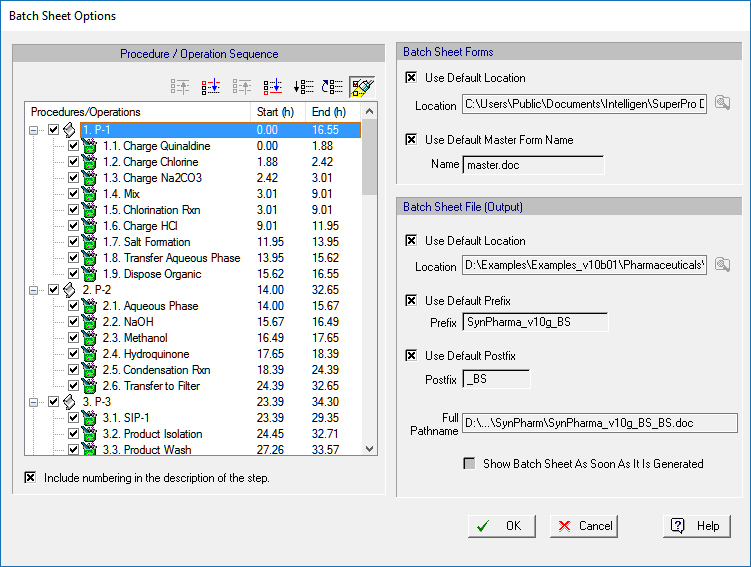
The Options interface dialog is divided into two parts. The left part contains a tree view of the procedures and operations. The procedures are displayed in the tree by default in increasing order of their absolute start time, and the operations of each procedure are also sorted by absolute start time.
The right part contains several file & folder options related to the location of the Batch Sheet forms, the name of the output file, etc.
For more details on individual options as well as customization options, see:
1. Procedure/Operation Sequence
3. Batch Sheet Output File Location
The procedure/operation sequence is presented in a tree view:
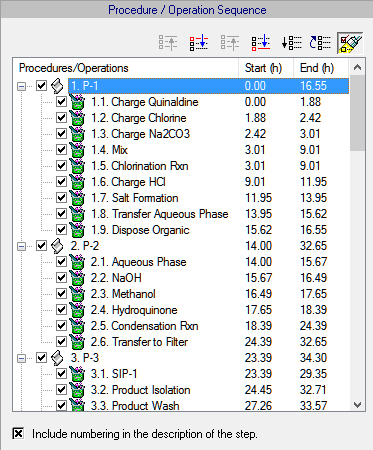
For each procedure and operation, the tree view contains the Start and End times (in hrs). Any procedure or operation can be excluded from the Batch Sheet by de-selecting its individual check box.
Checking the “Include numbering in the description of the step” check box will show all procedures and operations steps numbered in the outputted Batch Sheet report (1., 2., 3.,... for Procedures and 1.1, 1.2,.. 2.1, 2.2,.. etc for operation steps).
The procedure sequence can be modified through a series of interactive manipulations, which are grouped in a helpful toolbar on top of the tree view window. The toolbar is shown below magnified.

The above toolbar contains seven buttons, starting from left to right they can perform the following functions:
 Move selected procedure up one position in the list
Move selected procedure up one position in the list
 Move selected procedure down one position in the list
Move selected procedure down one position in the list
 Move selected procedure up to the top of the list
Move selected procedure up to the top of the list
 Move selected procedure down to the bottom of the list
Move selected procedure down to the bottom of the list
 Sort the procedures in order of ascending start times
Sort the procedures in order of ascending start times
 Reset to last saved sequence; Expand all nodes of the tree
Reset to last saved sequence; Expand all nodes of the tree
 Set input focus to the procedure list
Set input focus to the procedure list
The forms location is a non-editable text box. The location can be modified by first un-checking the Use Default Location check box and pressing the Explorer button on the right of the forms location edit box. If you recheck the Use Default Location checkbox it will revert back to its default location path.

The forms location defaults to Application Dir\BatchSheet, where “Application Dir” is the current SPD installation folder. The forms location can be specified by the user to be any valid folder in the user’s PC. You can set the default location by selecting the File/Application Settings menu option (from main menu).
Through this interface, only the top level batch sheet forms folder is specified, however the BatchSheet contains sub-folders for better organization of the forms. In the current version of SupePro Designer, the BatchSheet contains the following sub-folders: Procedures, Operations, Streams, Equipment, Components, StockMixtures and HXAgents.
|
|
The selection of a user-specified BatchSheet folder does not automatically place any forms under it, not does it create any sub-folders. The proper folder structure under BatchSheet as well as the existence of valid forms under its sub-folders, remains the sole responsibility of the user. |
The Master Form Name is displayed in an editable text box. You may enter your master form file name when unchecking the Use Default Master Form Name checkbox. This must be a file name only with the file type extension (.doc), not a full path. When rechecking the box it will revert to the default master form filename of “ProDesigner”.
The set of rules governing the search for a valid Master Form document is shown below:
● The master form is searched for in the current batch sheet output file location.
● If not found, the master form is searched for in the current forms location.
● If not found, the master form is searched for in the default Installation Dir\BatchSheet location.
This is the folder where the final batch sheet report will reside. The default value of this location is the folder where the current SPD case file resides. The user may select to use the default options that the dialog has provided or to define his own location path and filename prefix “SPD_case” and postfix “_BS” of the output “.doc” file. Finally the user may choose to show the batchsheet as soon as it is generated or just save it to the selected location to view later. Viewing of the generated Batch Sheet at a later time may be done by selecting from the main menu of SPD Reports/Batch Sheet/View to view the last generated Batch Sheet or Reports/Batch Sheet/View Any... to view any other generated Batch Sheet.

The master form document is a regular MS-Word document, which makes extensive use of “Text Form Fields” (from now on simply referred to as form-fields).
Users not familiar with form-fields in MS-Word are advised to read the Form-Field Tutorial for general instructions on viewing, adding, and modifying form-fields in MS-Word documents.
The master form document is essentially a collection of fields that are populated at run-time with updated data from the active flowsheet. The master form can be edited off-line and may contain any number of MS-Word formatting instructions and any amount of static text descriptions. However the heart of the master form document lies in reserved form-fields which are populated with flowsheet-related data.
It is important to realize that two distinct classes of reserved form-fields exist: single-value (SV) form-fields refer to flowsheet properties that can be displayed as a single number or text string; iterative forms (IF), on the other hand, point to other Word documents for the inclusion of flowsheet-related object collections (lists of streams, operations, etc.) into the master form document.
The concept of single-value (SV) form-fields and iterative forms (IF) applies to procedures, operations, streams, equipment, and HX agents; in other words, any procedure, operation, stream, equipment item, and HX agent present in the flowsheet can be included in the batch sheet and described through its SV or IF fields. As expected, iterative forms may contain references to other iterative forms based on context; see the formal Batch Sheet Specifications for details.
There is also a third type of form-field, which is formally neither a single-value nor an iterative form field; it is the special field (SF) and can be found in the generic operation template BatchSheet\Operations\Operation.doc. Its significance will be described in the following paragraph.
For generating a custom batch sheet description, the following files may have to be edited:
1. The master.doc file
2. The generic operation template Operation.doc
3. The specific operation templates
The generic operation template will normally contain some data common to all operations (ie operation name, operation comments, start/end times) and a reference to SPECIFIC_OP_SF, which actually instructs the inclusion of operation-specific data based on the specific operation templates. This template can optionally contain a reference to OPERATION_TIMING_SF which will print out a description about the scheduling dependency that other operation steps may have with this operation.
The process of creating a batch sheet description (master form document) from scratch, see Generating a Sample Master Document.
Form-fields are available in MS Word 2007 through the Developer Tab. To show the developer tab in the ribbon bar click on the office button:

and select word options. From the dialog that appears check the “Show Developer tab in the Ribbon” option. Select the Developer tab from the ribbon bar and click on the  Legacy Tools button, this will produce a toolbar as in the following image (Forms toolbar):
Legacy Tools button, this will produce a toolbar as in the following image (Forms toolbar):

For versions prior to MS Word 2007 you must expose the Forms toolbar by selecting View > Toolbars > Forms from the main menu.
The generation of a batch sheet description (master form document) requires extensive use of the so-called “Text Form Fields” available in the Forms toolbar.
To add/insert a new “Text Form Field” in the master document, press the  button on the Forms toolbar.
button on the Forms toolbar.
To delete an existing “Text Form Field” from the master document, left-click on the field to select it and press Delete, or delete it from the main MS Word menu via Edit > Clear (pre 2007 versions).
To edit an existing “Text Form Field”, double-click on it to bring up the “Text Form Field Options” dialog:
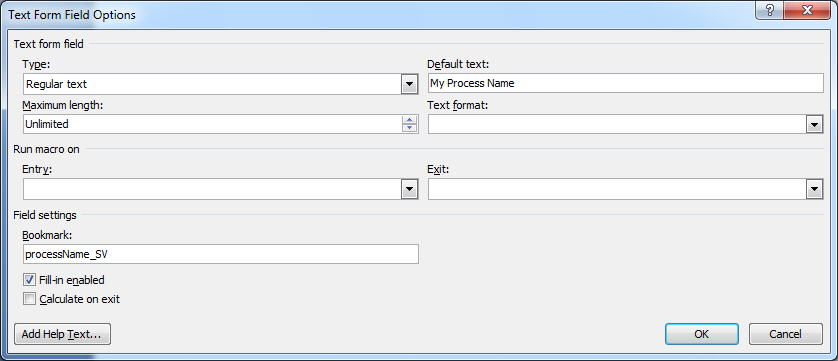
The most useful properties of the form field accessible from this dialog are its Bookmark name, its Type (text, number, date, etc.) and the Default text.
The following example shows the generation of a simple master form document from scratch. We wish to start our master form with a brief description of the process. Referring to the Flowsheet Single-Value Fields, we decide to use the processName_SV and SPDFileName_SV fields. We insert the first form-field into our master document. We make sure the Bookmark property of the field is edited to contain the single-value field name processName_SV. We do not have to provide a Default text for the field, but we may want to do so anyway:

Proceeding in a similar fashion, we add a second form-field into the master document and edit its Bookmark property to SPDFileName_SV:
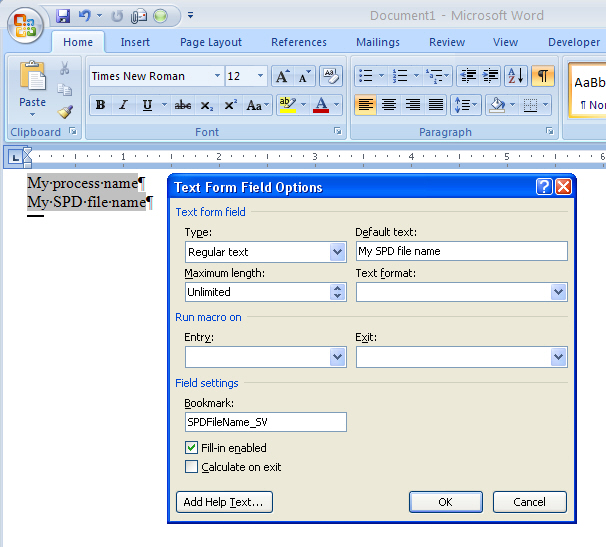
We wish to incorporate some stream information into the master document. Referring to the Flowsheet Iterative Form Fields table, we see that we can have iterative forms for all process streams, input streams only, and output streams only. We will concentrate on input streams in this example. We add another form-field into the master document and edit its Bookmark property to IN_STREAMS_IF_01. The Default text property of the field is now very important; it specifies the name of the iterative form that contains the input-stream description we desire.
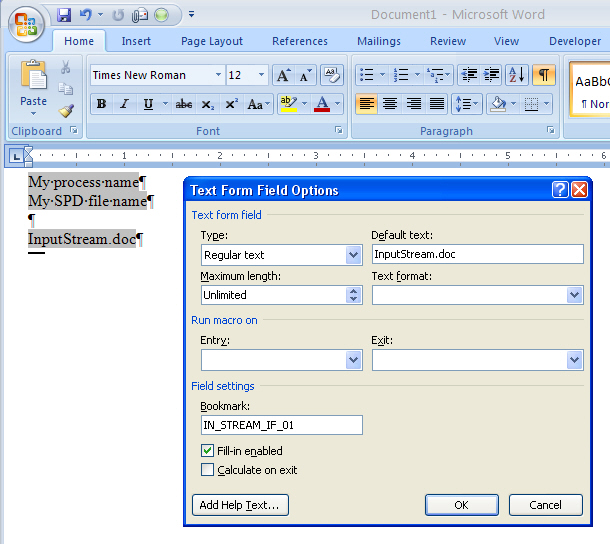
The file named “InputStreams.doc” may not exist yet. However, it is imperative that it is created prior to the batch sheet generation in the BatchSheet\Streams folder, and that it contains some valid stream fields. The tables Stream Single-Value Fields and Stream Iterative Form Fields can be consulted for this purpose. Step-by-step instructions on creating “InputStreams.doc” are available under Input Stream Form Details.
We are now ready to add our main iterative form field into the master document. Referring to the Flowsheet Iterative Form Fields table, we see that we can have iterative forms for all procedures. We add another form-field into the master document and edit its Bookmark property to PROCEDURES_IF_01. The Default text property of the field is again very important; it specifies the name of the iterative form that contains the procedure description we require:
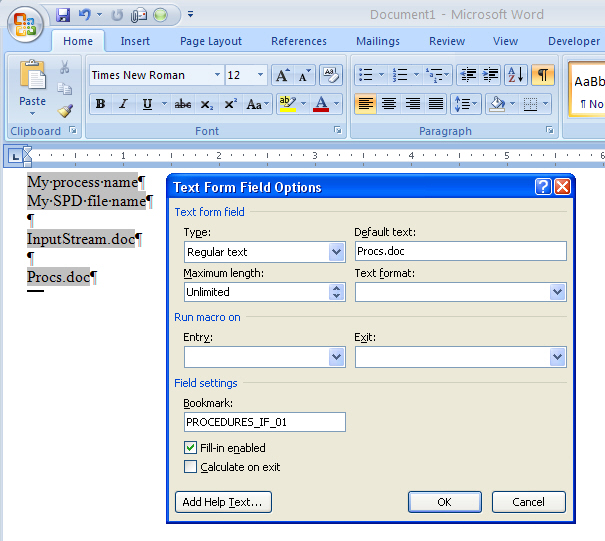
The file named “Procs.doc” may not exist yet. However, it must be created prior to the batch sheet generation in the BatchSheet\Procedures folder, and it must contain some valid procedure fields. The tables Procedure Single-Value Fields and Procedure Iterative Form Fields can be consulted for this purpose. Step-by-step instructions on creating “Procs.doc” are available under Procedure Form Details.
1. To create the “InputStreams.doc” template, create and save the Word file under BatchSheet\Streams. The file can initially be empty.
2. Design and draw/enter the visual elements of the document; we chose to use a bullet list for streams followed by a small table summarizing important stream properties.
3. Add eight (8) new form-fields as shown by the gray fields below.
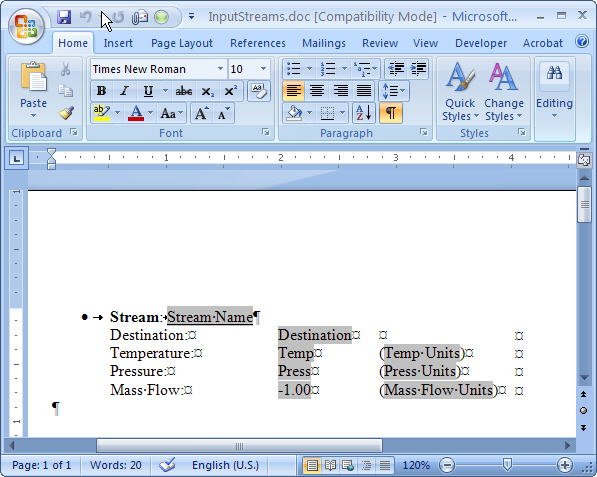
4. Visit every newly added form-field and edit its properties. The following picture shows the properties of the first field with the default text “Stream Name”:

It is important to enter a valid Bookmark name for the field, by referring to the Stream Single-Value Fields Table. In this case, the proper bookmark name is name_SV.
1. To create the “Procs.doc” template, create and save the Word file under BatchSheet\Procedures. The file can initially be empty.
2. Design and draw/enter the visual elements of the document; we chose to use solid lines for separating the procedure name from the rest of the description.
3. Add two (2) new form-fields as shown by the gray fields below.
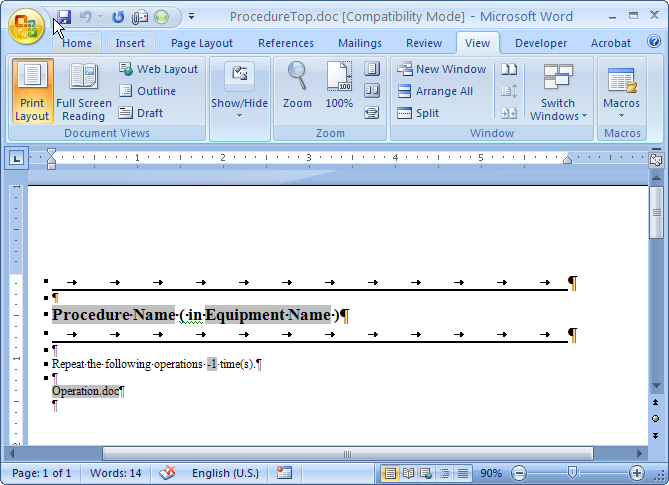
4. Visit every newly added single-value form-field and edit its properties. The following picture shows the properties of the first field with the default text ‘-1’:
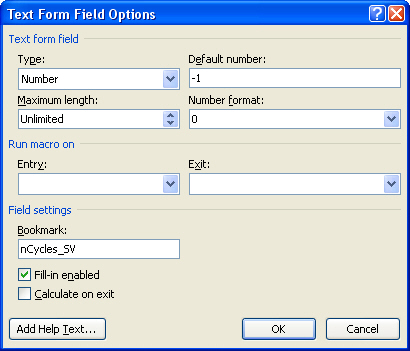
It is important to enter a valid Bookmark name for the field, by referring to the Procedure Single-Value Fields Table. In this case, the proper bookmark name is nCycles_SV. Notice also that the field Type must be changed to Number.
5. Visit every new iterative form field and edit its properties.
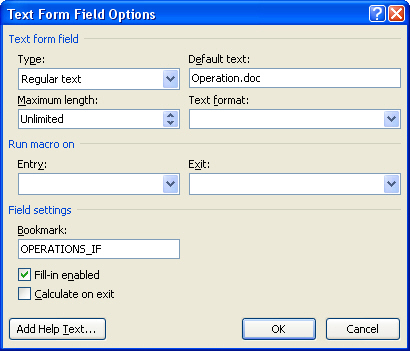
It is important to enter a valid Bookmark name for the field, by referring to the Procedure Iterative Form Fields Table. In this case, the proper bookmark name is OPERATIONS_IF. The default text points to the generic operation template “Operation.doc”.
The generic operation template can also be customized. Step-by-step instructions on performing the customization are available under Operation Form Details.
6. Open “Operation.doc” under BatchSheet\Operations.
7. Modify the visual elements of the document at will; we chose to use a table for common properties (start/end times).

8. Inspect the single-value fields. The following picture shows the properties of the first field with the default text “Operation Name”:
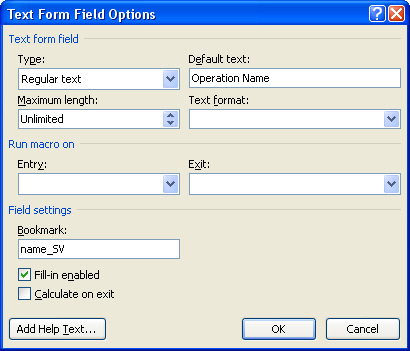
It is important to have a valid Bookmark name for the field, by referring to the Operation Single-Value Fields Table. In this case, the proper bookmark name is name_SV.
9. Notice the special field named “Detailed Instructions”. Specific operation data will be entered here at run-time.
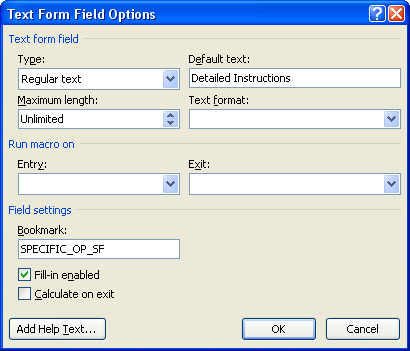
Any specific operation template can also be customized. Step-by-step instructions on performing the customization are available under Specific Operation Form Details.
10. The blank field under the field “Detailed Instructions” is set to display information about the scheduling dependency of other operations with this operation.

The scheduling dependency description field uses specific templates to fill in the information of the scheduling relations between operations. These templates are described in Specific Operation Timing Form Details.
Assuming that we need to modify a specific operation form, we can follow these simple steps to accomplish the customization. In the following, we will work with the familiar “Charge” operation for illustrative purposes:
11. Open the specific operation form “ChargeOp.doc” under BatchSheet\Operations.
12. Modify the visual elements of the document at will; add/remove form-fields by consulting the batchsheet specifications of the Charge operation.
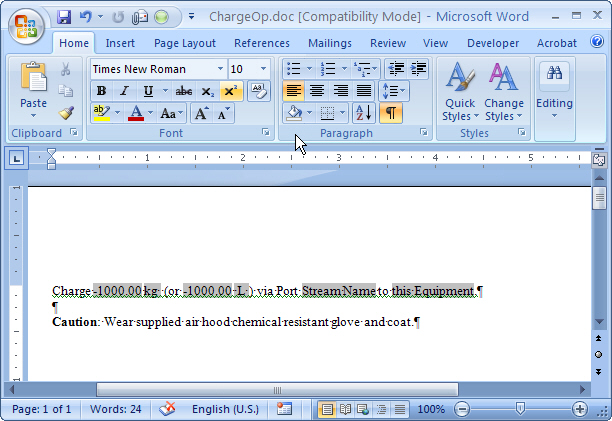
Inspect the single-value fields. The following picture shows the properties of the first field with the default name chargeMass_SV:
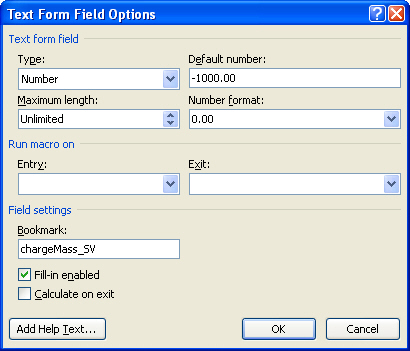
There are four different operation timing templates that cover all possible start or finish reference scheduling dependency links between operations. These can be located under ..\BatchSheet\Operations\ directory and have the following names:
● OperationTimingFTS.doc: Describes the relation when an operation starts with the end of the reference operation.
● OperationTimingSTS.doc: Describes the relation when an operation starts with the start of the reference operation.
● OperationTimingSTF.doc: Describes the relation when an operation finishes with the start of the reference operation.
● OperationTimingFTF.doc: Describes the relation when an operation finishes with the end of the reference operation.
In all above cases there may be a lead or lag time shift which can also be included. For more information on how to specify these scheduling dependency links, please see Operations Dialog: Scheduling Tab.
Bellow one can see the sample description in one of the above templates (OperationTimingFTS.doc). This text can be edited by the users in however way they prefer to accommodate their needs.
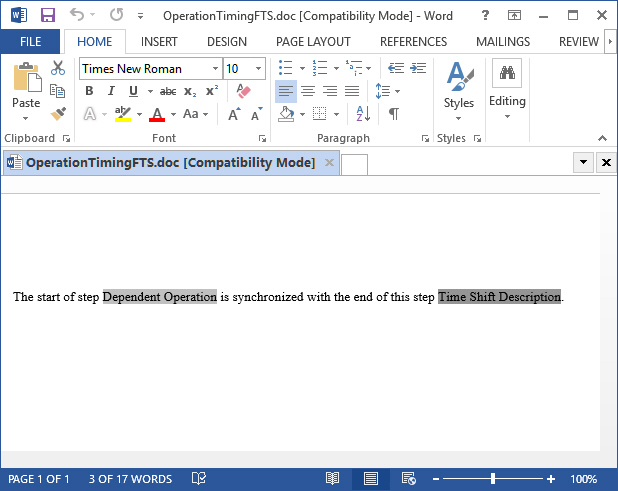
It contains the following Single Value fields:
● Dependent Operation - fullName_SV: The full name (Operation name in Procedure Name) of the dependent operation that references this operation (operation currently described).
● Time Shift Descritpion - timeShiftDscr_SV: This field contains the following description of the time shift if it exists: (with a lead/lag time of <time shift value>).